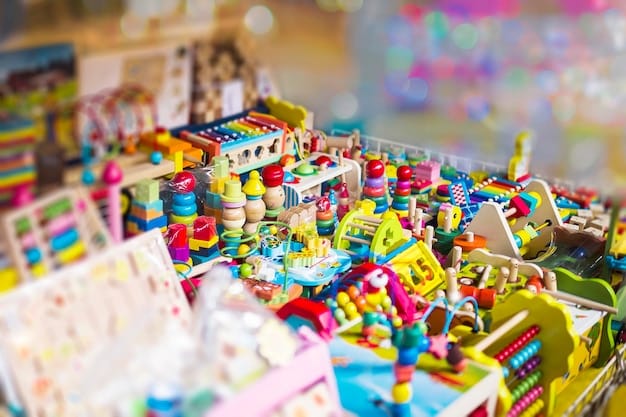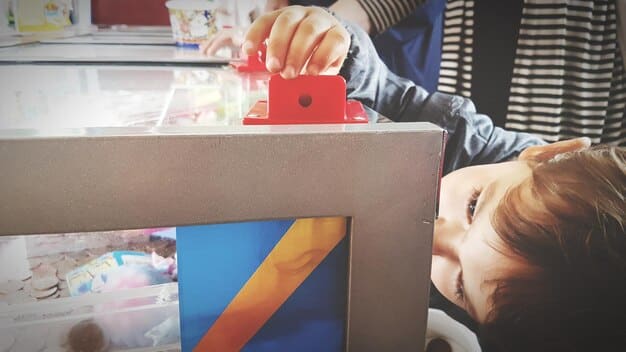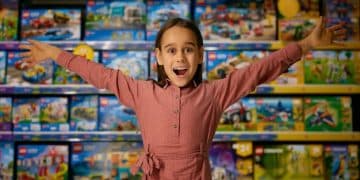Toy Trade Shows: Unveiling Tomorrow’s Playthings Today

Toy trade shows serve as pivotal platforms where manufacturers, designers, and retailers converge to preview the latest innovations and trends in the toy industry, offering a sneak peek at what will soon be captivating children and collectors in the US market.
Ever wondered where retailers and toy enthusiasts get a sneak peek at the hottest toys before they hit the shelves? The answer lies in **toy trade shows**, the epicenter of innovation and trendsetting in the toy industry.
The Allure of Toy Trade Shows: A Sneak Peek into the Future
Toy trade shows are more than just exhibitions; they are vibrant ecosystems where creativity meets commerce. These events provide a unique opportunity to witness the unveiling of groundbreaking toys, interactive technologies, and trendsetting designs long before they reach the broader US market.
For those in the know, attending or closely following these trade shows is akin to having a crystal ball, offering a glimpse into the future of play. They serve as a crucial meeting point for industry professionals, from manufacturers to retailers, influencers, and media representatives, all eager to discover the next big thing.
Why Toy Trade Shows Matter
Toy trade shows serve several critical functions within the toy industry:
- Innovation Showcase: They provide a platform for manufacturers to unveil their latest creations, highlighting technological advancements, design innovations, and unique play concepts.
- Networking Opportunities: Trade shows facilitate connections between manufacturers, retailers, distributors, and industry experts, fostering collaboration and partnerships.
- Trend Identification: Attendees gain valuable insights into emerging trends, consumer preferences, and market demands, helping them make informed decisions about product development and purchasing.
- Market Research: They offer a space for companies to gather feedback on new products and gauge market interest, allowing them to refine their offerings before mass production.
Trade shows also offer a chance for smaller and independent toy makers to gain visibility and compete with larger, established companies. Unique and innovative toys can capture attention and find their way into niche markets, contributing to a more diverse range of play options for kids.

Key Toy Trade Shows to Watch
Several major toy trade shows around the world act as barometers for the toy industry, each with its unique focus and regional significance. Keeping an eye on these key events is essential for anyone looking to stay ahead of the curve.
From the massive scale of Spielwarenmesse in Nuremberg to the targeted innovation focus of events in Asia, each trade show provides a distinct perspective on the global toy market and offers unique opportunities for industry professionals.
Spielwarenmesse (Nuremberg, Germany)
Spielwarenmesse is one of the largest and most international toy trade shows globally. Held annually in Nuremberg, Germany, it attracts exhibitors and visitors from over 130 countries.
- Comprehensive Coverage: The show features a wide range of toy categories, including traditional toys, electronic games, model railways, and hobby items.
- Global Platform: Spielwarenmesse provides a platform for companies worldwide to showcase their products and expand their international reach.
- Trend Gallery: The show includes a trend gallery that highlights emerging trends and innovative products, offering valuable insights for retailers and manufacturers.
Toy Fair New York
Toy Fair New York is the largest toy trade show in the Western Hemisphere. Held annually in New York City, it brings together thousands of exhibitors and attendees from around the world.
- Major Market Focus: The show caters specifically to the North American market, showcasing products and trends that are relevant to US consumers.
- Media Exposure: Toy Fair New York attracts significant media attention, providing exhibitors with valuable publicity and brand awareness.
- Educational Seminars: The show features educational seminars and workshops that cover various topics, including toy design, marketing, and retail strategies.
Hong Kong Toys & Games Fair
The Hong Kong Toys & Games Fair is the largest toy trade show in Asia. Held annually in Hong Kong, it serves as a gateway to the rapidly growing Asian toy market.
- Asian Market Access: The show provides a platform for companies to access the vast and diverse Asian toy market, including mainland China, which presents significant opportunities for growth.
- Manufacturing Hub: Hong Kong is a major manufacturing hub for toys, making the show a convenient place to source products and connect with suppliers.
- Innovation Focus: The show showcases innovative toy designs and technologies, highlighting the creativity and dynamism of the Asian toy industry.
Decoding the Trends: What to Look For
Successfully navigating toy trade shows involves more than just browsing booths and collecting samples; it requires a keen eye for emerging trends and a strategic approach to identifying the next big thing.
Attendees carefully analyze the product offerings, paying attention to key factors such as target demographics, competitive advantages, and potential for long-term market success. Understanding the nuances of the toy market is crucial for making informed purchasing decisions and staying ahead of the competition.
Sustainability and Eco-Friendliness
A growing trend in the toy industry is the focus on sustainability and eco-friendliness. Consumers are increasingly demanding toys made from sustainable materials and produced using environmentally responsible manufacturing processes.
Manufacturers are responding by offering toys made from recycled plastics, sustainably sourced wood, and organic cotton. These eco-friendly options appeal to environmentally conscious consumers and contribute to a healthier planet.
STEM and Educational Toys
STEM (Science, Technology, Engineering, and Mathematics) and educational toys continue to be popular, reflecting a growing emphasis on learning and skill development through play.
These toys are designed to engage children in hands-on activities that promote critical thinking, problem-solving, and creativity. They cover a wide range of topics, including coding, robotics, and scientific experiments.
Inclusivity and Representation
The toy industry is becoming more inclusive and representative, with manufacturers offering toys that reflect the diversity of the population they serve.
This includes dolls and action figures with different skin tones, hair textures, and body types, as well as toys that promote gender neutrality and challenge traditional stereotypes.

The Impact on the US Market: From Trade Show to Store Shelf
The journey from toy trade show to store shelf is a complex process involving product development, marketing, distribution, and retail. The decisions made at trade shows have a profound impact on the toys eventually available to consumers in the US market.
The trade show provides a critical first step, allowing manufacturers to gauge market reaction, refine their products, and secure orders from retailers. This process ultimately shapes the selection of toys that children and collectors will find on store shelves and online marketplaces.
Securing Retailer Commitments
One of the primary goals for manufacturers at toy trade shows is to secure commitments from retailers to carry their products. Retailers carefully evaluate the toys on display, considering factors such as price point, target audience, and potential for sales success.
Successful manufacturers will have compelling presentations, attractive displays, and persuasive sales pitches to convince retailers that their toys will be a hit with consumers. Securing these commitments is essential for ensuring that the toys make their way into retail channels and reach the broader market.
Refining Product Design and Marketing
Feedback gathered at toy trade shows is invaluable for refining product design and marketing strategies. Manufacturers can learn what features and benefits resonate with potential customers and make adjustments accordingly.
This may involve modifying the design of the toy, changing the packaging, or updating the marketing message. Incorporating this feedback ensures that the final product is well-received by consumers and stands out in a competitive marketplace.
Building Brand Awareness
Toy trade shows provide an opportunity for manufacturers to build brand awareness and gain media exposure. Attracting attention from journalists, bloggers, and influencers can generate buzz around the company and its products.
This increased visibility can lead to media coverage, online reviews, and social media mentions, all of which contribute to brand recognition and credibility. Ultimately, this increased brand awareness can translate into increased sales and market share.
The Digital Transformation of Trade Shows
In recent years, toy trade shows have undergone a significant digital transformation, with technology playing an increasingly important role in all aspects of the event. From virtual booths to online marketplaces, digital tools are enhancing the trade show experience for both exhibitors and attendees.
This digital transformation is enabling greater engagement, improved communication, and more efficient business transactions. As technology continues to evolve, the future of toy trade shows will likely be even more digital and connected.
Virtual and Hybrid Events
The COVID-19 pandemic accelerated the adoption of virtual and hybrid trade show models. Virtual events allow exhibitors and attendees to participate remotely, eliminating the need for travel and physical presence.
Hybrid events combine elements of both virtual and physical trade shows, offering a flexible and accessible experience for a wider audience. These models are likely to continue to be popular, even as in-person events resume, as they offer convenience and cost savings.
Online Marketplaces and Platforms
Online marketplaces and platforms are becoming increasingly important for toy trade shows. These platforms allow exhibitors to showcase their products online and connect with potential buyers from around the world.
They also offer features such as virtual showrooms, product demonstrations, and online chat, enhancing the virtual trade show experience. These platforms provide a valuable tool for manufacturers looking to expand their reach and connect with new customers.
Data Analytics and Insights
Data analytics are being used to gather insights into attendee behavior and engagement at toy trade shows. This data can be used to improve the trade show experience, personalize marketing efforts, and identify emerging trends.
For example, data analytics can track which booths are the most popular, which products are generating the most interest, and which attendees are the most engaged. This information can be used to optimize the layout of the trade show, improve product presentations, and target marketing campaigns more effectively.
Staying Ahead of the Curve: Maximizing Your Trade Show Experience
Whether you’re a manufacturer, retailer, or industry observer, maximizing your toy trade show experience requires preparation, strategy, and follow-up. By taking a proactive approach, you can gain valuable insights, build meaningful connections, and position yourself for success in the competitive toy market.
Before, during, and after the event, it’s crucial to set clear objectives, engage actively, and follow up diligently. This holistic approach will help you make the most of your investment and achieve your trade show goals.
Setting Clear Objectives
Before attending a toy trade show, it’s essential to set clear objectives. What do you hope to achieve? Are you looking to launch a new product, secure retailer commitments, or gather market research? Defining your objectives will help you focus your efforts and measure your success.
For manufacturers, objectives may include securing a certain number of retailer orders, generating media coverage, or gathering feedback on product prototypes. For retailers, objectives may include identifying new product opportunities, sourcing suppliers, or networking with industry experts. By setting clear objectives, you can ensure that you make the most of your time and resources at the trade show.
Engaging Actively
During the toy trade show, it’s important to engage actively and make the most of the opportunities available. Attend seminars and workshops, visit booths that interest you, and network with other attendees.
Don’t be afraid to ask questions, share your insights, and make connections. The more actively you engage, the more you’ll learn and the more valuable relationships you’ll build. Remember to collect business cards and take notes so you can follow up after the show.
Following Up Diligently
After the toy trade show, it’s essential to follow up diligently with the contacts you’ve made. Send thank-you notes, share information, and schedule follow-up meetings.
Keep the conversation going and nurture the relationships you’ve built. This is where the real work begins, as you convert contacts into customers and build lasting partnerships. By following up diligently, you can turn your trade show experience into long-term success.
| Key Aspect | Brief Description |
|---|---|
| 🚀 Innovation Hub | Trade shows unveil the latest toy innovations before they hit the US market. |
| 🤝 Networking | Shows facilitate collaborations between manufacturers, retailers, and industry experts. |
| 🌱 Sustainability | Eco-friendly toys are gaining prominence with sustainable materials and processes. |
| 💡 Educational Toys | STEM toys are in demand promoting learning and critical thinking skills. |
Frequently Asked Questions
Toy trade shows are industry events where manufacturers showcase their newest toys and games to retailers, distributors, and media representatives, previewing future trends.
They provide the first look at innovations which will eventually be sold in the United States, influencing the selection and availability of toys in American stores.
Expect trends in educational toys, eco-friendly materials, inclusivity representation, and tech integration like STEM toys.
No, both large and small companies participate. They are good level playing field for everyone, with some innovative smaller players breaking out.
The COVID-19 pandemic has led to more events being virtual or hybrid. These allow more participation irrespective of geographical proximity.
Conclusion
In conclusion, toy trade shows serve as vital hubs for discovering the latest innovations and trends poised to shape the US toy market.. These events provide a platform for manufacturers, retailers, and industry experts to connect, collaborate, and gain valuable insights into the future of play.





